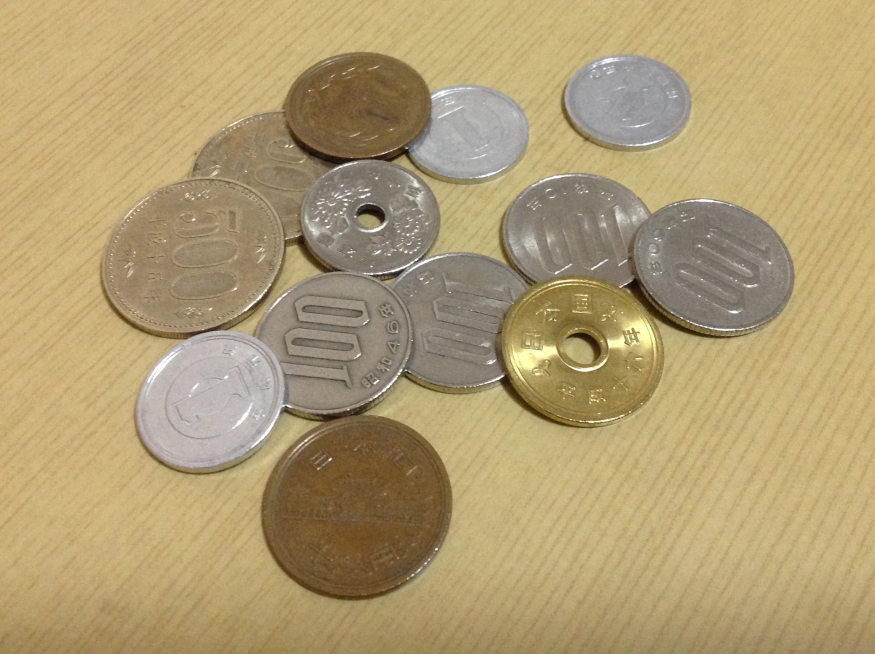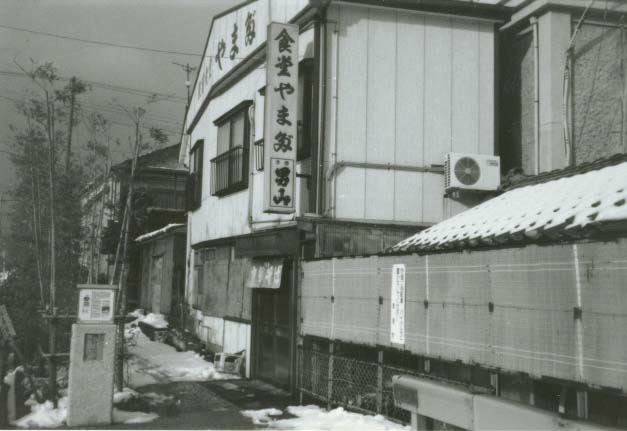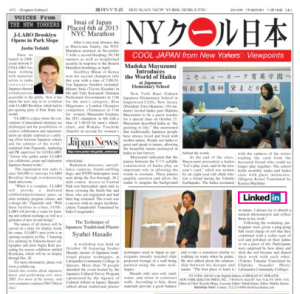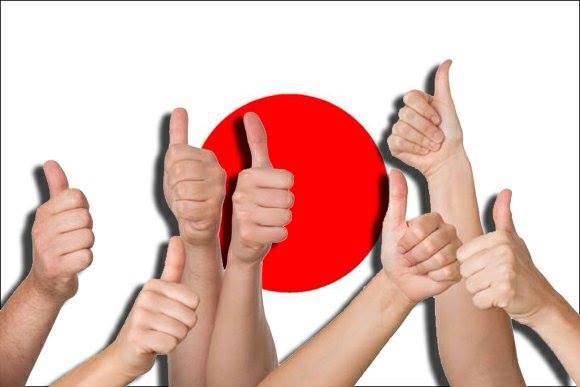【RocketNews24】7 things you should know before moving abroad
Posted by Michelle Lynn Dinh (Shimane-ken, Chibu-mura, 2010–13), editor and writer for RocketNews24. The following article was written by Jessica, a writer and translator for RocketNews24, a Japan-based site dedicated to bringing fun and quirky news from Asia to English speaking audiences.
I’ve lived abroad three times in my life. Once was a homestay in France, once was a semester studying in Germany, and now I live and work in Japan. I don’t expect that I will ever move back to the States. I love Japan and have wanted to live abroad almost as long as I can remember. Even so, it has sometimes been challenging for a girl from suburban Arizona who didn’t even get a passport until she was 18, and lately I’ve been wondering what I would tell my younger self to better prepare her for this crazy expat life.
With the help of our globetrotting friends, we’ve come up with this list of seven things you should know before moving abroad.
Kyodo News “Rural JET alumni” series: Elizabeth Gordon (Iwate)
News agency Kyodo News has recently been publishing monthly articles written by JET alumni who were appointed in rural areas of Japan, as part of promotion for the JET Programme. Below is the English version of the column from November 2013. Posted by Celine Castex (Chiba-ken, 2006-11), currently programme coordinator at CLAIR Tokyo.
*********

“I discovered through these exchanges that the people with whom I was talking wanted to know as much about me, about Chicago and about America as I wanted to know about them, Iwate and Japan. Through these interactions over the course of two years I began to gain a small understanding of the subtle nuances that were part of the culture in which I was living.”
Originally from Chicago, Elizabeth Gordon (Iwate-ken, Ninohe-shi, 2003-05) holds a Bachelors Degree in Psychology with a minor in Japanese Studies from Northwestern University, IL, and a Master’s degree in East Asian Studies from Columbia University, NY. She spent two years teaching English in rural Iwate before joining the Japan Foundation in New York as a Program Officer. She currently works as the Director of Private Events of the Adler Planetarium in Chicago.
Soba Diplomacy
Noodle making is an art, not to be taken lightly. Only a true master can produce the perfect noodle. After the wooden board is cleaned, the ingredients are kneaded in perfect rhythm until the correct consistency is achieved, and only the master knows for sure when that is. The rolling pin goes back and forth in a circular motion but forms a perfect rectangle, which is folded in half, then in half again, and in half again. Ever so delicately, the master cuts, slice after slice, all exactly the same width. They are cooked for just the right amount of time and then served with a simple dipping sauce sprinkled with scallions. The movements were ingrained in his muscles. I imagine he could have completed the whole process with his eyes closed. There is simplicity in the process, but the flavor is layered and complex.
When I arrived in Ninohe City, Iwate Prefecture in the summer of 2003 as a participant on the JET Program, I did not know a soul, nor had I ever heard of Iwate Prefecture. There was a short orientation in Tokyo, followed by a shorter orientation in Iwate’s capital city of Morioka. It was on the final day of orientation in Morioka that I met my supervisor, Mr. Sato. He picked me up and we drove the one and a half hours through the countryside back to Ninohe City. Mr. Sato did not speak much English and his heavy Iwate dialect was difficult for me to understand. We did, however, find common ground in a little bit of sports but mostly through food. I listed all of my favorite Japanese dishes, and he loved the fact that I could eat with chopsticks. He brought me to the Board of Education office and showed me my desk, which would be my home base for the next two years.
There was no rest for the weary, however. Before I could sit down I was whisked away on a driving tour of the entire city. We stopped at my two junior high schools and one of the eight elementary schools at which I would be teaching. I was asked to give a short self-introduction at each location. We also stopped at city hall to meet the mayor, and at the bank to open an account. Back at the board of education it was suggested that I be taken to the grocery store before I was dropped off at home for the evening. Read More
Justin’s Japan: Nippon in New York—Yayoi Kusama, Taka Kigawa, Taro Hakase, VAMPS
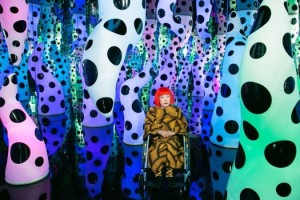
Yayoi Kusama with Love Is Calling (2013) installed as part of the artist’s inaugural exhibition I Who Have Arrived in Heaven at David Zwirner Gallery, on view through Dec. 21. (Will Ragozzino)
By JQ magazine editor Justin Tedaldi (CIR Kobe-shi, 2001-02) for Examiner.com. Visit his Japanese culture page here for related stories.
With Thanksgiving weekend (and the hopes of eating right) now just a memory, we turn to colder weather, falling snow, and the new year to come. Fortunately for Japanese culture fans, December is just as busy as the holiday season itself. Whether you’re hosting guests from out of town or looking to squeeze in an event or two in between parties, we’ve got you covered.
This month’s highlights include:
Now through Saturday, Dec. 21
Yayoi Kusama: I Who Have Arrived in Heaven
David Zwirner Gallery, 525 West 19th Street
Free
In case you missed last year’s retrospectiveat the Whitney featuring the artist’s mega-buzzed about Fireflies on the Water, this current exhibition by Yayoi Kusama features 27 new large-scale paintings and The Souls of Millions of Light Years Away, a new mirrored infinity room made especially for this exhibition and the United States debut of another infinity room, which was recently on view in Tokyo at the Mori Art Museum. Also exhibited is the artist’s video installation, entitled Manhattan Suicide Addict, that draws its title from her first semi-autobiographical novel published in 1978.
Wednesday, Dec. 4, 8:00 p.m.
Three’s Keys feat. Taka Kigawa
Klavierhaus Recital Hall, 211 West 58th Street
$15
As part of its third annual festival entitled Timbre Tantrum, Composers Concordance(“Enterprising new music organization” –New York Times) presents this all-piano production featuring Taka Kigawa (“Extraordinary pianist” –New York Times), Inna Faliks (“Signature blend of grace and raw power” –Lucid Culture) and Carlton Holmes (“Inventive” –Jazziz). Each pianist will present a 20-minute solo set of their own contemporary repertoire, including music by Shchedrin, Zhurbin, Ellington, Palkowski, Monk, and Alexander. The grand finale serves up a triple-piano suite composed by Dan Cooper, Sean Hickey, Debra Kaye, Milica Paranosic, and Gene Pritsker performed on Klavierhaus’ antique instruments, including a 19th century Pleyel.The concert will be followed by a brief reception.
Thursday, Dec. 5, 8:00 p.m.
Town Hall, 123 West 43rd Street
$49.50-$89.50
A violinist since the age of four, contemporary classical and crossover musician Taro Hakase returns to New York as part of his first-ever world tour. Entitled JAPONISM after his latest album, Hakase’s pop-infused compositions and charismatic showmanship are known to get fans dancing at his concerts. First brought to international attention following a collaboration soundtrack and a concert tour with Celine Dion in 1996, Hakase has performed before over two million people and has sold more than six million albums in Japan alone. Along with his eight piece band, Hakase brings his tour to one of New York’s most celebrated stages.
For the complete story, click here.
*****
Writer, researcher, and ex-JET Matt Leichter (Saitama-ken ’03-’05) will be presenting “College Education: Certain Debt, Uncertain Income” at the Henry George School of Social Science in New York City on Friday, December 20, at 6:30 PM. Here is the abstract:
Soaring costs for education, together with limited job opportunities and stagnant wage growth, place substantial financial and psychological burdens on students.
Noted columnist and researcher Matt Leichter reviews tuition inflation, cuts in public funding and the business of lending to students. Mr. Leichter will also propose reforms to the system of financing college education.
The school is located in Manhattan on East 30th Street between Park Avenue and Lexington Avenue.
JQ Magazine: Book Review – ‘Life in Japan: The First Year’

“Edison’s artistic talent captures Japan’s essence and his autobiographical account is honest and direct. JET Alumni will be able to follow his story and find many of their own experiences and thoughts represented within his work. From his first encounter ordering a hamburger to his dissatisfaction with being a glorified babysitter, his tone and pace keeps the reader hooked.” (Big Ugly Robot Publishing)
By Lana Kitcher (Yamanashi-ken, 2010-12) for JQ magazine. Lana is the business development associate for Bridges to Japan. To read more about Lana’s adventures in Japan and New York, visit her blog at Kitcher’s Café.
Victor Edison is a young man who remembers always having some Japanese influences present throughout his life. His family hosted a Japanese exchange student during his childhood, and he was fascinated by anime and manga from a young age. After graduation he found himself working a job he didn’t really want that wasn’t really going anywhere. A friend that was working in Japan at the time encouraged him to apply to be an English teacher and all he could respond to this was, “why not?”
Published by Nagoya-based Big Ugly Robot Press, Life in Japan: The First Year is a bilingual graphic novel written and drawn by Edison about his first year working for an English language school in Mie Prefecture. With little previous knowledge of the Japanese language or customs, he travels blindly to his new home armed only with his enthusiasm and determination to succeed, his ultimate goal to one day become a full-time artist.
His first choice was to work in Tokyo, simply because that was all he knew. After his interview with “Noba,” he soon learns that he has been offered a position in Mie, and accepts.
He starts work at an English conversation school located in a semi-rural area. While the majority of the clients were adults and young adults, the teachers often had to “teach” toddler classes as well. Because the school was located in a shopping mall, many parents would drop their kids off at the English school to fit in some uninterrupted shopping time. The teachers quickly learned that the child classes were thinly disguised babysitting sessions.
【RocketNews24】Why does the fifty yen coin have a hole? And other fun facts about Japanese coins
Posted by Michelle Lynn Dinh (Shimane-ken, Chibu-mura, 2010–13), editor and writer for RocketNews24. The following article was written by Master Blaster, writing team for RocketNews24, a Japan-based site dedicated to bringing fun and quirky news from Asia to English speaking audiences.
A fun way to get a perspective on another country’s history and culture is by looking at the currency used. The materials and design that go into making them can say a lot about what a country holds dear.
So, why don’t we take a quick look through the modern coins used in Japan and learn a little about why they look the way they do and some other tidbits along the way such as what happens when you microwave a one-yen coin and why you shouldn’t do it.
Kyodo News “Rural JET alumni” series: Nic Klar (Niigata)
News agency Kyodo News has recently been publishing monthly articles written by JET alumni who were appointed in rural areas of Japan, as part of promotion for the JET Programme. Below is the English version of the column from October 2013. Posted by Celine Castex (Chiba-ken, 2006-11), currently programme coordinator at CLAIR Tokyo.
********
Originally from Australia, Nicholas Klar (Niigata-ken, Itoigawa-shi, 1995-97) wrote the book “My Mother is a Tractor” about his life as an ALT in Omi, Itoigawa, Niigata-ken. After JET he worked for many years as a college counsellor and History teacher in international schools before returning to Japan to live. He now runs a small business in the Japan Alps, “Explore the Heart of Japan” as well as a popular travel website (http://myoko-nagano.com).
Remember that here all is enchantment, – that you have fallen under the spell of the dead, – that the lights and the colours and the voices must fade away at last into emptiness and silence. –Lafcadio Hearn
It was a stark winter’s day as usual in Niigata-ken, grey like sodden blanket. Not one that I had set out on seeking ghosts, but it suited the mood. As I changed trains in Naoetsu for Ōmi the old tempura stand I had been hoping for a snack at was still there, but today it was closed. It seems even the sturdy yukiguni could not stand the sort of weather that was being hurled at them this winter from across the Japan Sea. I settled into my seat, its soft orange covers familiar like an old friend, and waited for the delayed departure. I scrubbed the mist from the brown streaked windows with my hand as the motor idled and the minutes slipped by. Outside schoolboys in their traditional Prussian kit seem oblivious to the biting gusts of artic-like snow. Eventually with the sound of the station attendants whistle the doors snapped shut and the blue and white carriage groaned away from the platform.
As we crossed over the dark frigid waters of the Himegawa almost an hour later I grew excited. I hadn’t been back to the haunts of my old town for years. It was an unplanned visit and no-one really knew I was coming. I looked over for the local chugakko as the train passed by, obscured now by the construction of the new Hokuriku shinkansen. Framed behind those were the mountains I had loved so much. So many times I had taken my bike up into those North Alps making new discoveries, getting lost in the awesome beauty of its nature. Days of sunshine, days of rain. How I missed them. And the ghosts that inhabited them.
To the right there was a slight glimpse of my former apartment block. Not mine anymore, not for many years. In fact I think it now lays empty, apart from maybe a ghost or two, as the town depopulates. Tall, grey, forbidding – once referred to by a friend as, “…classic 1950’s communist Romanian style architecture”. The memory of that remark brought a brief smile to my face. Yet, it is the only place I will ever live in that has a sea view at the front and the mountains at the back. Grand views of God’s great vista on tap.
When the doors clunked open at Ōmi eki it was if nothing had changed. The chimes rang the same they had all those years ago and the black asphalt platform lay several centimetres thick with windswept snow. It felt soft under my feet as I began my ascent up the cold cement stairs. Standing in his post was my first metaphorical ghost – Watanabe-san the station master in the same blue-clad uniform, looking not a whit older than when we had last met a few years ago. He didn’t recognise me of course, even though I had taught his daughter at Ōmi chugakko. During my stay many of the station attendants had greeted me by name each time I passed through the gate. The inside of the station was a time capsule still painted the same green, apart from a more modern poster here and there, populated by even more ghosts of my memories. Local oba-chan in the waiting room still sat chatting on wooden bench seats around the kerosene heater behind glass doors. The three old shuttered-up ticket windows still existed – a sad reminder from the more grandiose boom days of Ōmi. Perhaps they were stubbornly retained in the forlorn hope that those times may yet return once again. Read More
CLAIR Magazine “JET Plaza” series: Anthony Bianchi (Aichi)
Each month, current and former JET participants are featured in the “JET Plaza” section of the CLAIR Forum magazine. The November 2013 edition includes an article by JET alumn Anthony Bianchi. Posted by Celine Castex (Chiba-ken, 2006-11), currently programme coordinator at CLAIR Tokyo.
********
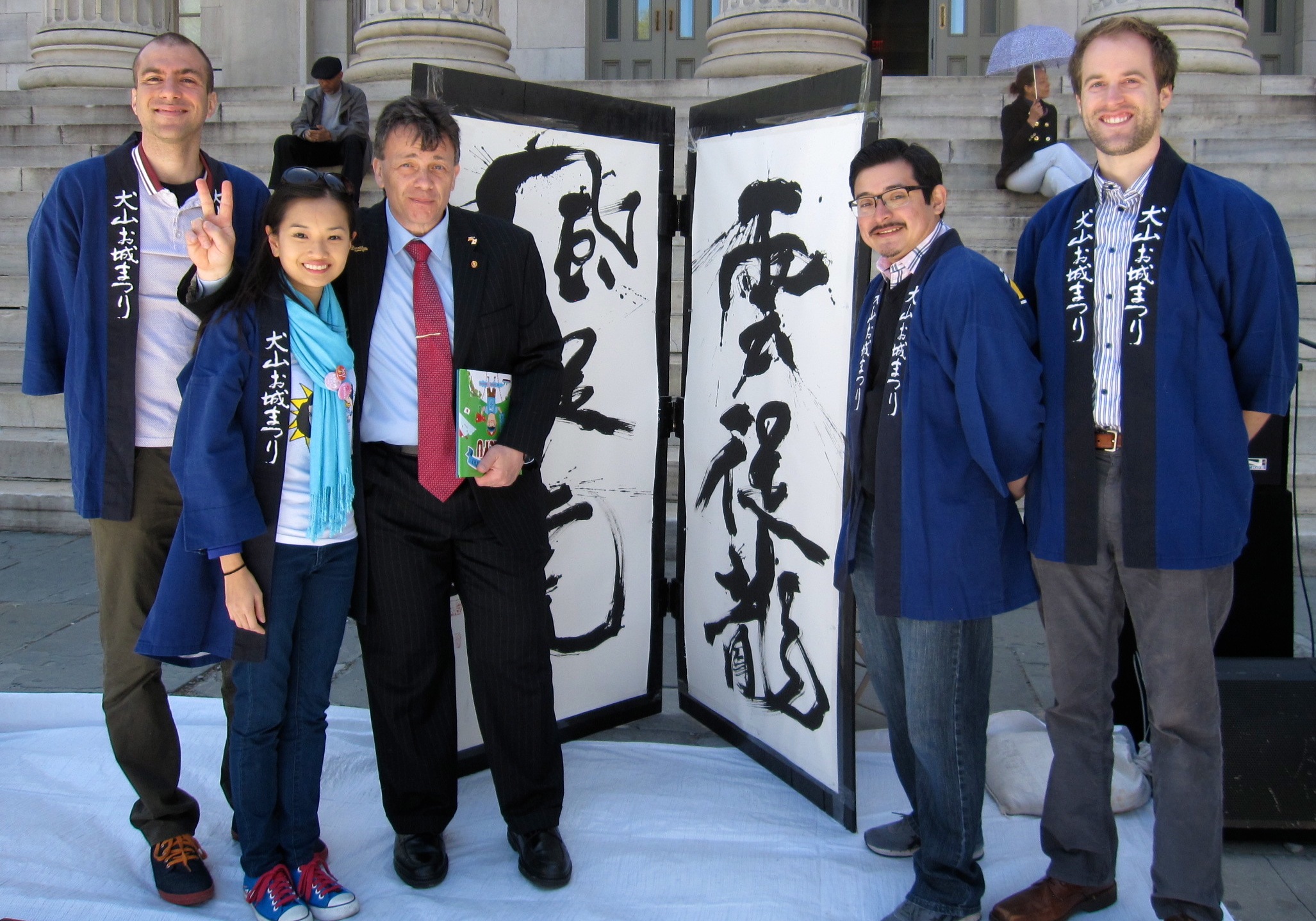
“Once you are in the programme, you are in the programme for life. As an Italian kid from the streets of Brooklyn, I get that. Like they say, when you’re a JET you’re a JET all the way, from your first cup of tea to your last hanami.”
A native of Brooklyn, New York, Anthony Bianchi (Aichi-ken, Kiyosu City, 1989-91), graduated from New York University with a degree in film making. After working on a number of television programs in Hollywood, he joined the JET Programme and spent two years working as an ALT in rural Aichi. A few years later, after overcoming many difficulties, he started the Native English Teacher (NET) Program, a teachers programme tailored for Inuyama City. Feeling there was a wall between the citizens and the city hall, he decided to run for the office and was voted into the city council of Inuyama City, Aichi Prefecture in April 2003. Anthony is currently serving his third term.
JET Generations
As anyone who has done so knows, living and working overseas in a different culture has a profound effect on all sides.
I have written before about how being on the JET Programme changed my life. To make a long story short, I would definitely not be here in Inuyama doing what I am doing had I not been involved in JET. Sometimes it still amazes me how things worked out. I mean, sometimes while I am making an argument on the council floor about some very local issue I still think, “How in the world did I end up here?” Conversely, I wonder at times what I would be doing if I had not joined JET some 25 years ago. Definitely something very different and most likely not as rewarding.
But the JET experience is certainly not only about what you get out of it, as I mentioned at the top, it is about the effect it has on all sides. As time passes I realize more and more that being a JET alumnus is a living thing that goes on after your contractual duties end. I still meet people involved with the programme that leads to great relationships and opportunities. Especially opportunities to give others even a small glimpse into another culture like the one we had by being part of the JET Programme. I am always impressed by the willingness of JET alumni to give back. A couple of summers ago I was asked to be on a panel at a national conference in Washington DC. Of course, there again, I met many outstanding alumni who are doing great things to promote cultural exchange and understanding between Japan and their home country. But I also realized that there is something about meeting former JET participants that has a camaraderie that is different and,in many ways, surpasses any other alumni association that I have known. I include in this group also Japanese staff and officials who have worked on the programme.
I would like to talk about a recent example. Out of my office, we run an exchange program called B. Bridges. We are a volunteer exchange group in our tenth year of existence. The idea for the group was seeded at an event the Brooklyn Borough President,Marty Markowitz, held for me at Borough Hall after my first election in 2003. There I was reacquainted with the administration of Xaverian High School. On that same trip I visited the school before returning to Japan. During that visit we decided to hold some kind of exchange.
JQ Magazine: 2013 JETAA Oceania National Conference Spotlights Sister City Relationships
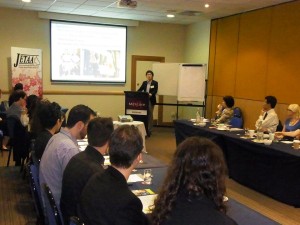
Hiromi Hakuta, assistant director of CLAIR Sydney, addresses alumni at the JETAA Oceania National Conference, Brisbane, Nov. 2013. (Courtesy of Hiromi Hakuta)
By Eden Law (Fukushima-ken, 2010-11). After the JET Programme more than fulfilled its promise of “an experience of a lifetime,” Eden returned to Sydney, Australia, where he joined the JETAA New South Wales chapter to take advantage of the network and connections available to undertake projects such as an uchiwa design competition for the Sydney Japan Festival. He also maintains the JETAANSW website and social media. Other than that, he’s a web designer and a poet, gentlemen and raconteur.
One of the best things about being a member of JETAA is the community, and over the weekend of 15-17 of November, the Oceania community of JETAA got together for our annual antipodean regional conference. For those of you up north who don’t know, JETAA Oceania comprises of five Australian chapters (the state chapters of Queensland, New South Wales, Canberra, the uber-chapter of South Australia-Victoria-Tasmania, Western Australia) and three New Zealand chapters (South Island, Auckland and Wellington). Representatives from Sydney’s CLAIR office (Tsuyoshi Ito, Hiromi Hakuta and Julien Ansart) attended as observers of the proceedings. This year, JETAA Queensland played host in Brisbane, the northern capital that looks to Asia and is close to the Gold Coast, a favoured destination for young Japanese looking for sun, surf and sand. Appropriately, we had our first lunch meet on Friday at MOS Burger, the famous Japanese fast food chain whose only non-Asian presence internationally is right in Brisbane.
JETAA Oceania was invited to attend the Welcome Back Reception for returning JETs at the Japanese Consul General’s home in Brisbane on the Friday night, a chance of course for us to network and hobnob with the cream of Brisbane’s Japanese cultural community. And after the reception finished (early, predictably), JETAA kicked on in town for a night out (hint: it’ll always involve karaoke—usually lots of obscure Japanese songs sung by that one quiet serious person who turns into a blurry, hip-thrusting maniac).
The first day of the conference began on Saturday, early (for some, too early) at our hotel and Laura Tasharofi, president of JETAA Qld, began proceedings by explaining the theme of this year: Australia-Japan sister-city relationships. As explained by Hakuta-san, of all countries, Japan has the most links in Oceania, with 108 sister city relationships in Australia and 44 in New Zealand. Therefore, the potential for JETAA to get involved is great, and the conference’s objective is to find ways to participate and be more prominent in our local communities. To start discussions and provide ideas and examples, two guest speakers, Ross Humphreys and Barry Hancock, were invited who are respected members of the Brisbane community and its influential sister city relationships.
【RocketNews24】Japanese elementary school teachers may tell you “5 x 100 = 500” is wrong
Posted by Michelle Lynn Dinh (Shimane-ken, Chibu-mura, 2010–13), editor and writer for RocketNews24. The following article was written by Master Blaster, writing team for RocketNews24, a Japan-based site dedicated to bringing fun and quirky news from Asia to English speaking audiences.
Here’s an elementary school math question for you all:
Apples are sold for 100 yen each. If you buy 5 what is the total amount?
If you said “5 × 100 = 500” then I’m sorry but you just flunked second grade math in Japan… if there were only one question all year. The reason is an old teaching method that is employed in elementary and middle schools throughout the country. It’s also a method that many, such as a blogger by the name of Uncorrelated, want stopped as it leads to strange logic where six times seven does not always equal 42 and five times 100 might not equal 500.
JQ Magazine: JETAA USA Earthquake Relief Fund Aids Recovery
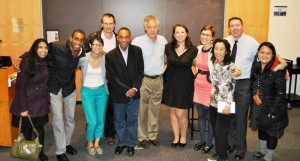
Taylor Anderson Memorial Fund founder Andy Anderson (center) with members of the JET Alumni Association of New York at Columbia University, Oct. 30, 2013. (Courtesy of JETAA New York)
By C-M Daeley (Saga-ken, 2008-2011) for JQ magazine. C-M is a poet, rap lyricist, and travel enthusiast currently working as an English teacher in Tokyo. For a look at some of his other writing, poetry and lyrics, check out his blog at http://spikedaeley.wordpress.com.
With today’s 24-hour global news cycle, it is sometimes difficult to keep even the most severe events in public memory. The Great East Japan Earthquake that struck on March 11, 2011 has not received much recent coverage in global news, but the issues faced by those still rebuilding remain monumental. Fortunately, there has been significant international aid from a number of sources, one of which is the JETAA USA Earthquake Relief Fund. This grant has raised almost USD $90,000 and has been used to provide seed funding to assist grassroots programs in areas severely impacted by the earthquake.
Due to the complex nature of fund allocation, this article will focus mainly on projects and programs directly supported through JETAA funds. However, it is significant to note that the Earthquake Relief Fund was only one of several avenues used to bring aid to the region and that, to date, roughly $500,000 has been raised through JET-affiliated groups and organizations worldwide. Jim Gannon (Ehime-Ken, 1992-94), current executive director at the Japan Center for International Exchange in New York, and Jessyca Livingston (Hokkaido, 2003-06), one of the three JETAA USA Country Representatives serving during the immediate aftermath and current JET Program coordinator at the Consulate-General of Japan in Denver, spoke about some of the initiatives the Earthquake Relief Fund has helped support.
“It is very difficult to give a concise yet comprehensive picture of what the JETAA funds have done,” Gannon explained. “The best way to describe it is that they have played a catalytic role in supporting some key projects in the early stage that have been supported by a range of others in more generous fashion once they proved their merits. JETAA cannot take full credit for all of the successes, but it did play an important role in getting things moving.” He also noted, “The real heroes are these incredible people from Tohoku who have championed these projects, the inspirational young people who have relocated to Tohoku to help operate them, and those who have been shuttling back and forth from Tokyo and elsewhere to help formulate and drive these initiatives.”
After a national discussion and several rounds of voting in each of JETAA USA’s 19 chapters, a final decision was made about how the fund should be allocated. “In the end, it was very obvious that chapters found it important to support education-related efforts in those areas most affected,” Livingston said.
Justin’s Japan: J-LABO Brooklyn Opens in Park Slope
By JQ magazine editor Justin Tedaldi (CIR Kobe-shi, 2001-02) for Shukan NY Seikatsu. Visit his Examiner.com Japanese culture page here for related stories.
Since its launch in 2008, social network J-COLLABO has been working with numerous artists to make innovative Japanese-themed collaborations accessible to the public. Now it has taken the next step in its evolution with J-LABO Brooklyn, which had its pre-opening party in Park Slope last month.
“J-LABO is a place where the conventions of intercultural chemistry are challenged and the possibilities of creative collaboration and experimentation are deeply explored as a unifying effort between Japanese culture and the cultures of the world,” explained John Figueredo, marketing and PR supervisor for J-COLLABO. “Artists who gather under J-LABO can collaborate, create and implement Japanese-themed works.”
The organization now seeks to raise $40,000 to renovate J-LABO Brooklyn through crowdsourcing funds and events.
“When it is complete, J-LABO will provide a dedicated exhibition/performance space, an artist residency program, classes, and a design lab,” Figueredo said. “With these facilities as a base, J-COLLABO will provide a venue for learning and cultural exchange as well as a generator of new art and design.”
The names of all donors will be carved on a plate for display inside the venue. J-LABO’s next event is an opening reception on Dec. 7 featuring live painting by Fukuoka-based calligrapher and artist Sugita Koki preceding his newest exhibition entitled Kotokama, which will be on display through Dec. 20.
For more information, please visit www.j-collabo.org.
【RocketNews24】10 things Japan gets awesomely right
Posted by Michelle Lynn Dinh (Shimane-ken, Chibu-mura, 2010–13), editor and writer for RocketNews24. The following article was written by Philip Kendall (Fukushima-ken, Shirakawa-shi, 2006–11), senior editor and writer for RocketNews24, a Japan-based site dedicated to bringing fun and quirky news from Asia to English speaking audiences.
At the end of our recent article listing the 10 things that we think Japan gets horribly wrong, we assured you that we’d be back soon to focus on some of the positives and introduce the things that we really, truly love about living in Japan. True to our word, we sat down and decided on what we as (mostly) foreigners most love about this great little collection of islands, and it turned out to be a lot of fun.
Although Japan is not without its faults, it is nevertheless an incredibly efficient and easy-to-live-in country, and we’ve discovered that there are numerous things that the Japanese get not just right, but awesomely right.
Join us after the jump for our top 10 things we love about Japan.
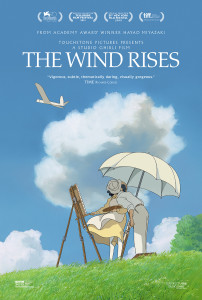
“The Wind Rises is a combination of everything that makes Studio Ghibli as we know it today. It also adds several new elements which make this film dynamic and, some say, controversial.” (Touchstone Pictures)
By Alexis Agliano Sanborn (Shimane-ken, 2009-11) for JQ magazine. Alexis is a graduate of Harvard University’s Regional Studies—East Asia (RSEA) program, and currently works as an executive assistant at Asia Society in New York City.
Written and directed by Hayao Miyazaki, The Wind Rises is like no Studio Ghibli movie I have ever seen. No. Wait. It’s like every Ghibli movie I have ever seen. You want fantasy? You got it. You want airships à la Castle in the Sky or Nausicaä of the Valley of the Wind? You got it. You want deliciously portrayed food? You want nostalgic scenery from bygone days of Tokyo or picturesque European towns? You got that, too. The Wind Rises is a combination of everything that makes Ghibli as we know it today. It also adds several new elements which make this film dynamic and, some say, controversial.
One of the most differentiating factors is that The Wind Rises is the only full-length feature to focus on an actual historical figure—Jiro Horikoshi, the designer of the Mitsubishi A5M, a fighter aircraft of World War II. Granted, Miyazaki used his artistic license to embellish the narrative—but he does that only to make things more beautiful and fantastical. (And that’s why we love Miyazaki, right?)
Watching The Wind Rises, you feel repeatedly—and indeed the entire plot more or less focuses on—Japan’s desperation to achieve modernity according to “Western standards.” But modernization was not a smooth road, and Miyazaki makes that message clear. Despite the beautiful veneer, the crux of this film lies in the frustration of a country and its people. Economic deflation, poverty, and limited resources repeatedly arise as roadblocks. (This may explain part of the reason for its amazing popularity in Japan. Frustrations, impatience and desperation exist within every generation.) Yet, as Jiro is reminded, even with setbacks and disappointments, one must live on and progress despite it all.
【RocketNews24】10 things Japan gets horribly wrong
Posted by Michelle Lynn Dinh (Shimane-ken, Chibu-mura, 2010–13), editor and writer for RocketNews24. The following article was written by Philip Kendall (Fukushima-ken, Shirakawa-shi, 2006–11), senior editor and writer for RocketNews24, a Japan-based site dedicated to bringing fun and quirky news from Asia to English speaking audiences.
It should come as no surprise to our readers to hear that we’re big fans of Japan. Pretty much everything here works as it should, the food is amazing, the culture rich, and people are on the whole likeable and friendly. But there are times when Westerners, and Japanese who have spent any amount of time abroad for that matter, realise that Japan gets some things not just wrong but horribly wrong. So join us after the jump as we redress the balance no doubt offset by our constant admiration of Japan by discussing the 10 little things that drive us nuts in this otherwise great country.


